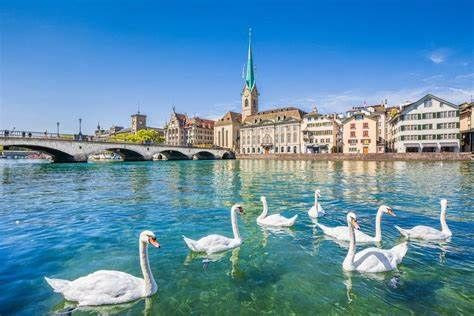Culturally vibrant, efficiently run, and attractively set at the meeting of river and lake, Zurich has emerged as one of Central Europe's hippest destinations.
====================================================================(in north-central Switzerland), Zurich, the country's largest city, and the capital of the canton of Zurich, is found in an Alpine setting at the northwestern end of Lake Zurich, The city stretches out between two forested chains of hills, not far from the northern foothills of the Alps. Two rivers, the Limmat and Sihl, run through the city. Zurich’s western and northeastern limitations are formed by the Albis mountains, which include the 2,850-foot [870-meter] , considered the “top” of Zürich, with an idyllic view of the lake.
+ Permanently settled for more than 2,000 years, Zurich was founded by the Romans, who called it Turicum. In 1519, Zurich became a primary center of the Protestant Reformation in Europe.
+ Many museums and art galleries can be found in the city, including the Swiss National Museum and Kunsthaus. (Schauspielhaus Zürich is generally considered to be one of the most important theaters in the German-speaking world.) Zurich is home to many financial institutions and banking companies.
+ In 1218 Zurich became an imperial free city, and in 1351 it joined the Swiss Confederation, a coalition of cantons that were opposed to the Austrian Habsburgs. In 1336 the citizens accepted a constitution that, based democratically on the guild system, balanced the power of the various crafts, the trades, and the nobility. As the guilds became more powerful, the city was able to purchase its freedom from the emperor in 1400, and tax obligations were lifted. Zürich became embroiled in conflicts with neighboring territories, but economic growth continued relatively unimpeded. Staging repeated successful forays into the surrounding countryside, the city began controlling an even larger part of it; moreover, Zürich profited from being conveniently located on both the southbound trade route, centred on the St. Gotthard Pass, and the east-west route from the Rhône River to the Danube.
+ Napoleon’s occupation of Switzerland in 1798 ended the old political order, and Zurich was reorganized under the Helvetic Republic, which tried to form a unitary Swiss state. The disputes ended in 1803 when Napoleon mediated, and the canton of Zurich, dominated by the city, became a sovereign member of a new Swiss Confederation. The political rule exerted by the aristocratic ancien régime was replaced by a liberal democratic order by 1816.
+ Under the Swiss constitution of 1848, the autonomous cantons became federal states, each with its own constitution. The people of Zurich adopted a new constitution in 1869, which served as a model for other Swiss cities and influenced the revision of Switzerland’s national constitution in 1874.
+ In the mid-19th century the University of Zürich and the Swiss Federal Institute of Technology were founded. (Zürich also boasts a long line of Nobel Prize winners.)





No comments:
Post a Comment